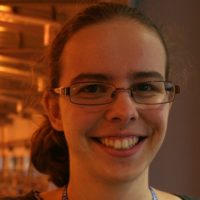About me
I am a structural biologist with a particular interest in understanding structural cellular changes. I graduated from the University of Sheffield with a BSc in Biochemistry and Genetics. Between the 2nd and 3rd years of my BSc I completed a summer internship at Diamond Light Source using soft X-ray tomography and 3D structured illumination microscopy to characterise mammalian cell organelles. This sparked my interest in structural biology of whole cellular systems. In my 3rd year I then did an x-ray crystallography project which helped to confirm my love of research and structural biology. I decided to pursue a PhD in electron microscopy as this is fast becoming the way to study both whole cells and proteins. The excellent electron microscopy facilities at Sheffield, especially the new Tecnai Arctica cryo-electron microscope, led me to the decision to stay at the University of Sheffield to undertake a PhD with Prof. Per Bullough and Dr. Robert Fagan looking at the structure and function of Clostridia spores.
My project
Clostridia are Gram-positive, spore-forming anaerobic bacteria with many species within the genus being pathogenic. Clostridium difficile is one such species where infection can cause a range of symptoms, the most severe being pseudomembranous colitis and toxin megacolon which can be fatal. Clostridium botulinum is another member of the Clostridia and is capable of producing a deadly neurotoxin with extremely high potency making it a significant bioterrorism threat. Key to the survival of these species is the production of dormant, highly resistant spores. These spores can remain viable for long periods of time and withstand extreme environments that vegetative cells could not. Germination of spores is triggered by specific molecules being detected by receptors found within the spore structure. Understanding the process of sporulation, the structure of endospores and the process of germination is crucial to tackling the threat posed by these Clostridia species.
In my project I am focussing on the germination process of both C. difficile and Clostridium sporogenes (a model for C. botulinum) spores to characterise the changes that occur structurally to enable this process to happen. To do this I am using a range of microscopy techniques, including light microscopy, electron crystallography and cryo-electron tomography.
Connect
Twitter: @Hannah_Fisher2
LinkedIn: Not yet available.

